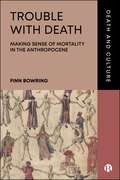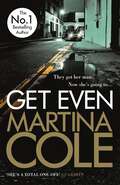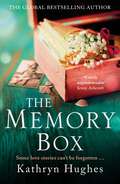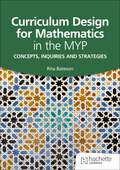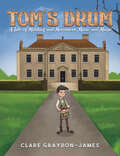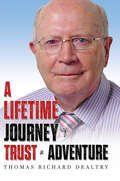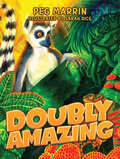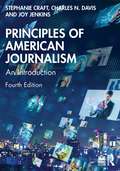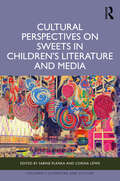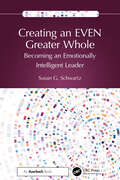- Table View
- List View
Urban Form and Urban Heat Island: Towards a Cool Built Environment (Urban Sustainability)
by Youpeng LuThis book provides a comprehensive exploration of the spatial patterns, drivers, mechanisms and management strategies associated with urban heat islands (UHI). It presents new insights into how urban form shapes the thermal environment of cities, shedding light on previously unexplored aspects of UHI dynamics and urban cooling strategies. The key features of this book include: 1. Comprehensive coverage of the influence of urban form on UHI intensity, from spatial patterns to regulatory strategies. 2. Practical implications and recommendations for urban planning and policy formulation to mitigate UHI effects and enhance urban sustainability. Written for researchers, urban planners, policymakers and environmental practitioners, this book provides valuable insights into understanding and addressing the challenges posed by UHI in rapidly urbanising environments. It is suitable for advanced graduate level courses in urban studies, environmental science and geography.
Innovations in Mini Blast Furnaces: Toward Sustainable Metallurgy (Topics in Mining, Metallurgy and Materials Engineering)
by Aitber Bizhanov Pruet Kowitwarangkul Sergey Gavrilovich Murat Alexander Rostovskiy Suporn KittivinitchnunThis book provides a comprehensive exploration of modern hot metal and ferroalloy smelting technologies, focusing on mini blast furnaces as a key player in the global transition to green metallurgy. Drawing from years of practical experience and scientific insights, the book offers a field-tested description of these furnaces, providing practical recommendations and optimizing operational modes to significantly reduce carbon dioxide emissions. From theoretical foundations to practical applications, this book is useful for engineers, researchers, and industry professionals interested in the landscape of eco-friendly metallurgical practices.
Science Pitch: Präsentieren Sie Ihre Forschung. Kommen Sie auf den Point.
by Stephen WagnerWie können WissenschaftlerInnen ihre Projekte mit Power auf den Point präsentieren? Als ultimativer Leitfaden übersetzt dieses Buch komplexe Forschung in überzeugende Kurzvorträge. Das innovative ESPRIT-Modell gibt WissenschaftlerInnen die nötigen Tools an die Hand, um Professionalität mit Persönlichkeit zu verbinden und so ihr Zielpublikum zu überzeugen. Dieses Praxis-Handbuch integriert Anwendungen der Künstlichen Intelligenz (KI) und Foliengestaltung. Praxisorientierte Tipps mit konkreten Beispielen zeigen auf, wie Studierende und Forschende sichtbar als ExpertInnen wahrgenommen werden können. Mit diesem einzigartigen Leitfaden können sie prägnante Botschaften vermitteln sowie fachliche Expertise und persönliche Leidenschaft zu einem einzigartigen wissenschaftlichen Storytelling verbinden. Der Science Pitch ermöglicht überzeugende Kurzvorträge, erfolgreiches Networking und die Zusage von Fördermitteln für Forschungsprojekte.
Rural Road Development in Developing Countries (SpringerBriefs in Applied Sciences and Technology)
by Jagat ShresthaThis book provides guidelines for the planning, design and construction of rural roads in hilly regions. It is a useful resource for researchers and practitioners working in the field as it presents different rural road network concepts for new construction and upgrades of existing infrastructure. the book introduces the covering-based rural road network method that discovers nodal points to cover settlements and public facilities within a given region by developing a basic rural network. It also explores different mathematical models including a multi-objective approach for solving a rural road network upgrading problem for typical rural road network structures for hilly regions. It also presents case studies to help readers grasp the basic principles presented in the text. This book can also additionally be utilised as a reference resource for graduate and undergraduate students interested in rural transportation.
Trouble with Death: Making Sense of Mortality in the Anthropocene (Death and Culture)
by Finn BowringAre we accepting of death, or in denial of it? What insights can we gain from the ways death has been imagined, theorized, and organized throughout Western social and intellectual history that might help us respond meaningfully to the climate emergency? This interdisciplinary study begins with the role of tragedy in Greek antiquity and examines European attitudes toward death, especially their entanglement with colonial atrocities and politically organized killings. Drawing on the work of philosophers, sociologists, historians, and psychoanalysts, this is a resounding call to confront our responsibility for the lives of others—and the future of life itself—amid the existential threats of the Anthropocene.
Get Even: A dark thriller of murder, mystery and revenge
by Martina Cole* Don't miss GUILTY, the brand new novel from Martina Cole. Out now. *They got her man. Now she's going to get even...GET EVEN, by the 'undisputed queen of crime writing' (Guardian) and Sunday Times No.1 bestseller Martina Cole tells the hard-hitting tale of the fearless Sharon Conway as she finally gets her shot at revenge... Sharon Conway and Lenny Scott are childhood sweethearts. Everyone says they are too young, but nothing can keep them apart. Sharon doesn't question Lenny's business dealings and it isn't long before his reputation as a hard man destined for the top means they are living the good life with their sons.But one night Lenny doesn't come home. It isn't the first time he has gone AWOL. But it is his last. He is found murdered - beaten to death in an act of brutality that shocks even the police. And Sharon never knows why.Now, twenty years later, Sharon is about to find out the truth. Such a crime cannot go unpunished. Revenge is long overdue. The time has come to... GET EVEN.If you love powerful female characters, be sure to also read Martina Cole's GOODNIGHT LADY, THE KNOW and CLOSE. These ladies are strong, resilient and vengeful...
The Memory Box: A heart-breaking historical novel set partly in World War Two, inspired by true events, from the global bestselling author
by Kathryn HughesSome love stories last a lifetime...'UTTERLY UNPUTDOWNABLE' Jenny Ashcroft'Wow, wow, wow!!! The BEST BOOK I have read all year. A gorgeous story which had me hooked. Make sure you have a box of tissues when you read this beautiful story ⭐ ⭐ ⭐ ⭐ ⭐'_______From the million-copy-bestselling author of The Letter, Kathryn Hughes, and inspired by true events, an unforgettable, moving and timeless story of love and war which will stay with you for ever. Readers who adored The Nightingale, The Notebook or The Tattooist of Auschwitz will love to unlock The Memory Box...Jenny Tanner opens the box she has cherished for decades. Contained within are her most precious mementoes, amongst them a pebble, a carving and a newspaper cutting she can hardly bear to read. But Jenny knows the time is finally here. After the war, in a mountainside village in Italy, she left behind a piece of her heart. However painful, she must return to Cinque Alberi. And lay the past to rest.After a troubled upbringing, Candice Barnes dreams of a future with the love of her life - but is he the man she believes him to be? When Candice is given the opportunity to travel to Italy with Jenny, she is unaware the trip will open her eyes to the truth she's been too afraid to face. Could a place of goodbyes help her make a brave new beginning?_______Will you be the next reader to lose your heart to The Memory Box?'A heartbreaking and heartwarming tale of love, loss and forgiveness' Daily Mail'A spellbinding tale with lots of surprises and endearing characters. Hughes is a wonderful storyteller' Woman's Weekly'I could not put this book down! It is absolutely phenomenal from the very first page... it is heartbreaking, joyful and hopeful ⭐ ⭐ ⭐ ⭐ ⭐''I've loved every single one of Kathryns' books, but this one was my absolute favourite! ⭐ ⭐ ⭐ ⭐ ⭐''The twist at the end made me gasp! ⭐ ⭐ ⭐ ⭐ ⭐''I absolutely loved this book. Devoured it in a few days. I eagerly await more of Kathryn Hughes' books. I will be first in line. Excellent ⭐ ⭐ ⭐ ⭐ ⭐''What a gorgeously written tale... heartbreaking but also heartwarming. Full of unexpected twists, this one had me gripped! ⭐ ⭐ ⭐ ⭐ ⭐''A stunningly beautiful story. Brilliantly developed characters. A heart-warming and emotional read that I read in one sitting ⭐ ⭐ ⭐ ⭐ ⭐''A heartwarming, well-written story. Heartbreaking in places but a story that had to be told ⭐ ⭐ ⭐ ⭐ ⭐'
Cambridge IGCSE First Language English Fifth Edition
by John Reynolds Ayoola OgunmuyiwaThis title is endorsed for the Cambridge Pathway to support the syllabuses for examination from 2027. Written by experienced authors and teachers, our Student's Book provides accessible and engaging support for the latest Cambridge™ IGCSE and IGCSE (9-1) First Language English syllabuses (0500/0990). - Prepare thoroughly for all course components with extensive practice exercises designed for learners at all levels, ensuring comprehensive learning.- Engage with practical themes, such as travel, exploration, people and community.- Develop reading comprehension, analysis and evaluation with a variety of text types and genres, plus annotations to aid understanding. - Improve writing skills with sample answers and teacher commentary, and establish a strong background in spelling, punctuation and grammar.- Expand communication skills with advice on holding presentations and responding to questions confidently. - Consolidate learning with the 'Remember' feature, key terms and definitions, extra questions, end-of-chapter checklists and practice tests. - Deepen understanding by progressing from main ideas to complex questions. Answers to all the practice questions and activities are FREE to download from: www.hachettelearning.com/answers-and-extras
SmartMaths Standards 4 and 5
by Karen MorrisonMaster All Levels of Primary Mathematics Through a Comprehensive Educational Framework. Boost the educational journey of every student with resources that are culturally relevant, accessible and engaging, available in both print and digital formats.· Cultivate mastery of key mathematical concepts through clear, straightforward explanations using step-by-step guidance and real-life examples.· Streamline SEA preparation from the start with a structured course. Beginning with Standard 1 and progressing seamlessly to a focused resource for Standards 4 and 5, prepare students for the SEA with extensive exercises and exam preparation materials that cater to diverse learning styles.· Engage with culturally relevant content authentically reflecting Trinidad and Tobago's local environments, cultures, and realities, developed and reviewed by local contributors and a Consultant Editor.
Cambridge IGCSE and O Level Geography Fourth Edition
by Garrett Nagle Paul GuinnessWe are working towards endorsement of this title for the Cambridge Pathway to support the syllabuses for examination from 2027.Written and reviewed by experienced authors and teachers, our Fourth Edition Student's Book provides accessible and engaging support for the latest Cambridge IGCSE™, IGCSE (9-1) and O Level Geography syllabuses (0460/0976/2217) for examination from 2027.Revised and updated with a refreshed design, this new edition provides accessible content for all learners, enhanced question practice and support and a clear route through the updated syllabuses with an improved structure.- Trust experienced authors to guide you through the updated syllabus with comprehensive coverage of all the geographical themes, skills and coursework required. - Navigate the syllabus confidently with clear signposting and individual chapters for each topic, along with in-depth guidance on geographical skills and fieldwork. - Build and reinforce understanding of all learners with a clear layout, accessible language and ESL-friendly key terms.- Deepen understanding of geographical concepts through up-to-date examples from around the world.- Prepare for assessment and check comprehension with new analyses of detailed specific examples, practice questions, knowledge tests and activities throughout.- Consolidate learning with definitions of key terms, topic summaries, additional questions and images online. Answers to all the practice questions and activities are FREE to download from: www.hoddereducation.com/cambridgeextras
Curriculum Design for Mathematics in the MYP: Concepts, inquiries and strategies
by Rita BatesonEverything you will ever need to create an innovative, supportive MYP Mathematics Curriculum. Rita Bateson is the former Senior Curriculum and Assessment Manager for the IB and oversaw the last curriculum review. In this book you will find a one-stop shop for everything Middle Years Programme, from planning through delivery and assessment.
Cambridge IGCSE First Language English Fifth Edition
by John Reynolds Ayoola OgunmuyiwaThis title is endorsed for the Cambridge Pathway to support the syllabuses for examination from 2027. Written by experienced authors and teachers, our Student's Book provides accessible and engaging support for the latest Cambridge™ IGCSE and IGCSE (9-1) First Language English syllabuses (0500/0990). - Prepare thoroughly for all course components with extensive practice exercises designed for learners at all levels, ensuring comprehensive learning.- Engage with practical themes, such as travel, exploration, people and community.- Develop reading comprehension, analysis and evaluation with a variety of text types and genres, plus annotations to aid understanding. - Improve writing skills with sample answers and teacher commentary, and establish a strong background in spelling, punctuation and grammar.- Expand communication skills with advice on holding presentations and responding to questions confidently. - Consolidate learning with the 'Remember' feature, key terms and definitions, extra questions, end-of-chapter checklists and practice tests. - Deepen understanding by progressing from main ideas to complex questions. Answers to all the practice questions and activities are FREE to download from: www.hachettelearning.com/answers-and-extras
SmartMaths Standards 4 and 5
by Karen MorrisonMaster All Levels of Primary Mathematics Through a Comprehensive Educational Framework. Boost the educational journey of every student with resources that are culturally relevant, accessible and engaging, available in both print and digital formats.· Cultivate mastery of key mathematical concepts through clear, straightforward explanations using step-by-step guidance and real-life examples.· Streamline SEA preparation from the start with a structured course. Beginning with Standard 1 and progressing seamlessly to a focused resource for Standards 4 and 5, prepare students for the SEA with extensive exercises and exam preparation materials that cater to diverse learning styles.· Engage with culturally relevant content authentically reflecting Trinidad and Tobago's local environments, cultures, and realities, developed and reviewed by local contributors and a Consultant Editor.
Cambridge IGCSE and O Level Geography Fourth Edition
by Garrett Nagle Paul GuinnessWe are working towards endorsement of this title for the Cambridge Pathway to support the syllabuses for examination from 2027.Written and reviewed by experienced authors and teachers, our Fourth Edition Student's Book provides accessible and engaging support for the latest Cambridge IGCSE™, IGCSE (9-1) and O Level Geography syllabuses (0460/0976/2217) for examination from 2027.Revised and updated with a refreshed design, this new edition provides accessible content for all learners, enhanced question practice and support and a clear route through the updated syllabuses with an improved structure.- Trust experienced authors to guide you through the updated syllabus with comprehensive coverage of all the geographical themes, skills and coursework required. - Navigate the syllabus confidently with clear signposting and individual chapters for each topic, along with in-depth guidance on geographical skills and fieldwork. - Build and reinforce understanding of all learners with a clear layout, accessible language and ESL-friendly key terms.- Deepen understanding of geographical concepts through up-to-date examples from around the world.- Prepare for assessment and check comprehension with new analyses of detailed specific examples, practice questions, knowledge tests and activities throughout.- Consolidate learning with definitions of key terms, topic summaries, additional questions and images online. Answers to all the practice questions and activities are FREE to download from: www.hoddereducation.com/cambridgeextras
Curriculum Design for Mathematics in the MYP: Concepts, inquiries and strategies
by Rita BatesonEverything you will ever need to create an innovative, supportive MYP Mathematics Curriculum. Rita Bateson is the former Senior Curriculum and Assessment Manager for the IB and oversaw the last curriculum review. In this book you will find a one-stop shop for everything Middle Years Programme, from planning through delivery and assessment.
The Things That Made Elliott Cry
by Gisela Everett WalkerA gentle guide for children aged 5-9 who struggle with the challenges of everyday life.This heartwarming story follows Elliott, a young boy facing common difficulties like bullying, family troubles, shyness, and low self-esteem. As Elliott navigates his day, he encounters the emotions that can make life feel overwhelming. But with a little guidance, he learns valuable ways to manage his feelings and transform his outlook. This book offers children a reassuring companion in understanding their emotions, helping them find hope and confidence in themselves and their world.
An Old Lady’s Haiku with Cat
by Barbara LoreiAt this point in my life, I&’m committed to my work, driven by a deep desire to communicate and explore the many mysteries around us. In a time when it&’s more urgent than ever to care for nature and one another, I create not just to please, but to provoke – to gently pause others in their tracks, inviting them to experience the profound, the playful, and perhaps to leave a little bit changed.My art and haiku often draw on mythology, religion, nature, and personal memories. In this way, I see myself as a storyteller, hoping to intrigue anyone who takes a moment to stop and look.
Tom's Drum: A Tale of Mischief and Merriment, Music and Magic
by Clare Graydon-JamesIs young Will a thief? Is young Tom playing tricks? Why are Tom’s parents angry with the cook and the haughty servant? Why do the elves, gnomes and pixies visit Tom’s grand house and Will’s humble cottage on Christmas Eve? Tom’s Drum provides answers to these questions. It also paints a lively picture of Britain during the early reign of Queen Victoria: when the rich and the poor, the masters and the servants, were expected to know their places. A story of music and magic, families and friendship, Tom’s Drum begins and ends with Christmas, but is guaranteed to entertain young readers at any time of the year. And as this is a fairy tale, someone is sure to have a happy ending: but who will it be?
The Green Sock Sole Mates
by Johnathan OgleSyd and Lorraine are a pair of green socks – and soulmates. But somehow, Syd has become separated from Lorraine! Join them on an exciting adventure as they navigate the twists and turns of their journey to reunite and become a pair once more, ready to be worn together by their owner.
A Lifetime Journey of Trust & Adventure
by Thomas Richard DealtryA Lifetime Journey of Trust & Adventure is a classic, warm, and inspiring recollection from Richard’s childhood, during wartime, to the heights of management in government and business development. Read this personal and reflective real-time life account. This is an intriguing book for everyone who has a progressive personal interest in a challenging lifetime journey.
Doubly Amazing
by Peg MarrinAnimals captivate children not because they mimic human abilities, but because they possess extraordinary adaptations that seem almost beyond human reach. With whimsy, inventive language, and playful rhyme, Doubly Amazing celebrates the remarkable talents of quadrupeds, winged creatures, and aquatic wonders. From the familiar elephant to the exotic axolotl, each animal appears twice, paired with a different counterpart to highlight their unique skills in a fun, lighthearted competition of one-upmanship. As young readers discover these fascinating abilities, they may begin to wonder: if animals are so gifted, where do humans stand? The answer might surprise them.
Principles of American Journalism: An Introduction
by Stephanie Craft Charles N. Davis Joy JenkinsDesigned to engage, inspire and challenge students while laying out the fundamentals of the craft, this textbook—now in its fourth edition—introduces readers to the core values of journalism and its singular role in a democracy.From the First Amendment to artificial intelligence, this popular textbook provides a comprehensive exploration of the guiding principles of journalism and what makes it unique. Authors Stephanie Craft, Charles N. Davis and Joy Jenkins cover the profession's ethical and legal foundations, its historical and modern precepts, the economic landscape of journalism, the relationships among journalism and other social institutions and the key issues and challenges that contemporary journalists face. They also discuss the current ambiguities and transitions—economic and technological—occurring in the field, from nonprofit news sites to social media’s effects on journalism.Filled with relevant case studies, exercises and discussion questions that encourage critical thinking about journalism and its role in society, this book helps students become better-informed media consumers as well as more mindful practitioners of journalism.
Raising and Lowering Vibration Isolator via Asymmetric Damping Adjustment: Application in Vehicle Height and Attitude Control
by Zhihong Li Jialing YaoThis book introduces an approach of controlling vehicle height and attitude by actively raising and lowering vibration isolators via asymmetric damping adjustment.The first section of this book identifies the theoretical foundation of asymmetric damping adjustment and discusses practical applications and the significance of this advancement. The second section discusses the mechanics and laws governing the active raising and lowering of the vibration isolator. The final two sections present the application of this method by incorporating a number of control strategies, including model predictive control, hybrid model predictive control, and active disturbance rejection control. The methodology is validated through simulation and co-simulation under various vehicle conditions.This book will be of interest to automotive engineers and those interested in the field of mechanics, vibration, and control.
Cultural Perspectives on Sweets in Children’s Literature and Media (Children's Literature and Culture)
by Sabine Planka Corina LöweOur language is full of 'sweet' terms to describe situations (‘a bittersweet moment’), things (‘popcorn brain’), behaviour (‘to have a sweet tooth’), or even loved ones (‘sweety’, ‘sweetheart’, ‘honey’) that are originally not linked to food. What seems to be common to almost all cultures, is reflected in the fact that we humans are born with a taste for sweets, and that sweets have shaped our cultures and our language. This has also been reflected in children's literature and media. This is the starting point for this invaluable collection of essays, which deals specifically with sweets and the spectrum of hedonistic and regulated indulgence in different cultures and media for children. The contributions analyse classics of children’s literature, but also more recent texts and other media such as magazines, films, television programmes and computer games. Cultural Perspectives on Sweets in Children’s Literature and Media creates a kaleidoscope of the various functions of sweets and their significance for children’s culture, thus providing an overview of the diversity of the subject.
Creating an EVEN Greater Whole: Becoming an Emotionally Intelligent Leader
by Susan G. SchwartzLeadership is not a solo sport; it’s about people and how they engage with one another. True leadership isn’t driven by an individual’s ego, but by the ability to connect, understand, and inspire others. Emotional Intelligence (EQ) enables leaders to shift their mindset, empowering their teams to reach their highest potential. Creating an Even Greater Whole: Becoming an Emotionally Intelligent Leader offers managers a fresh perspective and practical tools to navigate their leadership journey.




